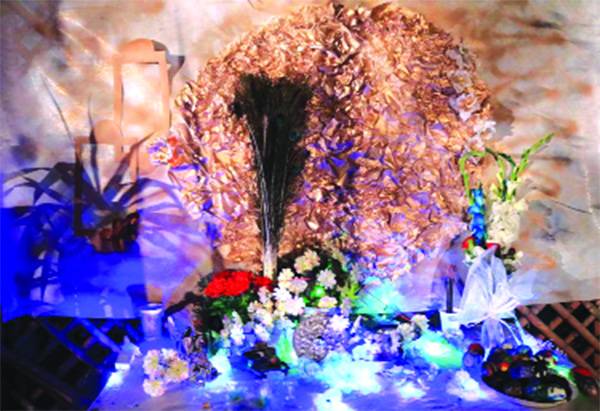
Something very unusual happened in Lahore this March. A celebration took place, which at first sight, appeared highly unlikely in today’s Pakistan.
I must confess that when I first heard that it was going to happen, I was not terribly confident of its success. They told me young people were going to gather to mark Nowruz – the ancient celebration of spring, renewal and fire that takes place every spring equinox. Populations from the Caucasus and Zagros mountains all the way to northern India have historically observed it. With roots in ancient Iran, it predates Islamic civilisation, but in the Persianized Islamicate world, it quickly became very much a festival of Muslims – Sunni and Shia alike. The Mughals celebrated Nowruz in a big way: some 19 days every year.
Nowruz is marked by a number of ethnic and religious groups in Pakistan, but is allowed little space from the state and the cultural mainstream. Just last year, religious extremist thugs from the Islami Jamiat Talaba (IJT) attacked Pakhtun students celebrating Nowruz and Pakhtun culture on the campus of Punjab University. This attempt at violent moral policing by the shock troops of General Zia’s Pakistan led to a fierce physical clash.
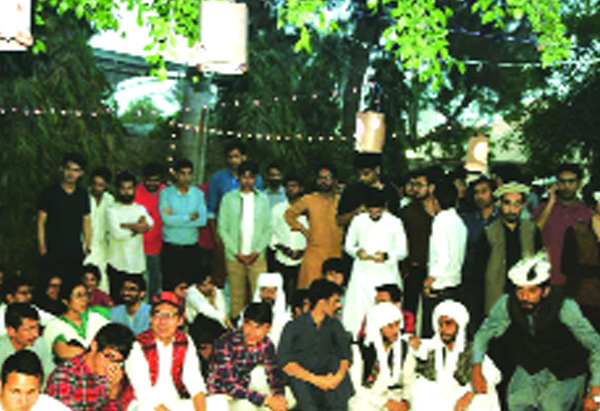
In any case, I remember telling the young people organizing this year’s celebration in a residential area: “Of course, I will be there, but please don’t get your hopes too high. Plan for around 30 to 40 people. I’ll probably know 20 of them because they’ll be from my social circle. You know, progressives – journalists, writers, academics, those types!”
I could not have been more wrong. It turned out to be bigger and more beautiful than I could have ever imagined.
But before I confess to the reader precisely how wrong I was, let the reader allow me a reprieve to explain why I had my doubts.
You see, I belong to the generation that was born in the final years of General Zia-ul-Haq’s fundamentalist dictatorship. By the time we understood anything, we were in another dictatorship. The “enlightened moderation” of General Musharraf, his dance moves on a stage at Independence Day celebrations, the emerging bands and music scene, the clashes over women running in marathons – none of this could mask the fact that we were born into a cultural desert. And to those few of us who read about the (recent) past, particularly Zia’s nightmarish surgery on Pakistani society, it became very clear that the desert was very much manmade.
The few of us who imagined something different knew that the lights had been put out by design. As if to reinforce that, the Taliban and other fundamentalist fighters struck at state and society with a vengeance around 2007-08 – just when we were old enough to be allowed to go out unsupervised. Authority figures, from parents to campus administrators, suddenly had a new excuse to prevent young people from gathering at a concert or even the juice-and-ice-cream corner: “the terrorists will murder everyone there!”
Could it be that the terrorists were simply employing extra-violent means of protecting ‘hamaray bachay’ (our children) from corrupting Western influences, Indian/Bollywood “cultural imperialism” and the dangerous notions of freedom that come with it all? Suspicious types like me were joining dots that we were not supposed to…
In any case, years later, the number of terror attacks has gone down, but the draconian measures taken by families and educational institutions to police young people remain in place.

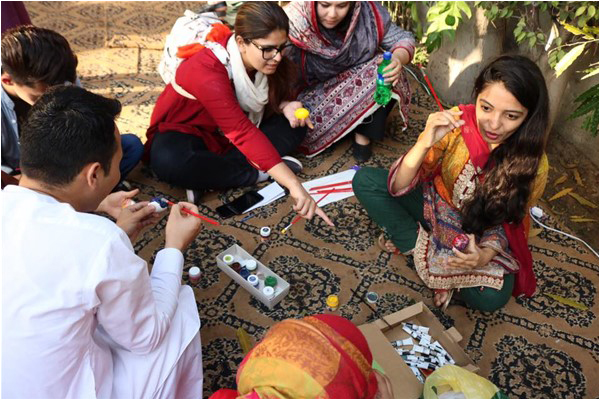
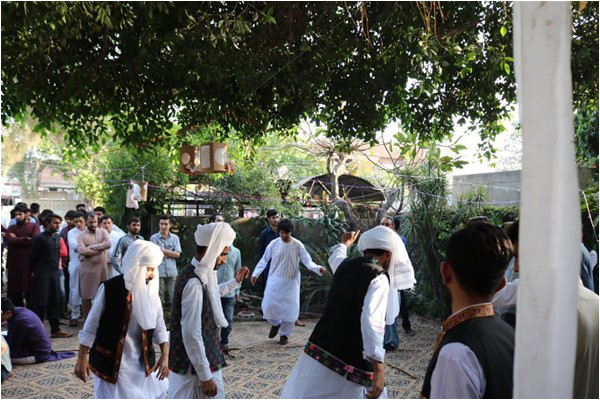
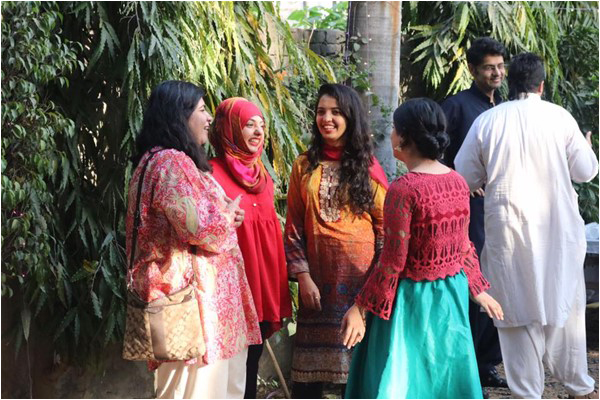
It was with such thoughts in mind that I skeptically made my way to an event organised by the Nowruz Festival Committee in Lahore this March. I found that it was taking place in a lawn decorated gorgeously with white streamers, flowers and various stalls.
And as mentioned earlier, I was completely wrong with my dark broodings.
As I entered, a lively Pashto tune was playing. A number of young Pakhtun students were performing a vigorous attan dance. Long hair flew in the breeze, shalwars flared up as they went about in a most energetic rhythm.
Further down, I could see a beautiful Haft Seen – the traditional Nowruz display which features seven items beginning with the alphabet ‘seen’, set up to celebrate life and in the hope for prosperity and wellbeing.
To my left, Sindhi students had set up a stall displaying some of the treasures of their heritage – fabrics, ajrak designs, succulent dates and a big copy of the epic Shah Jo Risalo.
A bit further on, there was a stall by Mamtu de Hunza: a startup by young people from Gilgit-Baltistan, handing out piping hot plates of mamtu – delicious meat-filled dumplings done in Central Asian style.
Students and other young people from Gilgit-Baltistan could easily be identified with their marvelous mountain-caps – each with a jaunty feather to adorn it. Young people of a Hazara background, dressed in traditional finery including some lovely waistcoats, were hurrying about, preparing for a musical performance of their own.
In one corner, young people sat painting eggs, led by artists. This, too, is a traditional and much-loved aspect of Nowruz celebrations.
Baloch youth walked about in traditional finery, heads held high, heads wrapped in spotless white turbans and shalwars worn in glorious flowing coils.
To everyone’s joy, very soon enormous pots of Kabuli pulao arrived and a feast began.
And there were not 20 or 30 people, as I had dismally predicted to the organizers a few days before this. There were hundreds of youth. With all the activity going on, and people going in and out, it was difficult to even count.
I stood utterly dazed at what the organizers had unleashed and these hundreds of young people had seized upon – spring had come to Lahore!
Many of these students and young people were from parts of Pakistan that are far from the major cities. They came from regions that are economically and politically marginalised. Their culture and history is treated as ‘foreign’ – or as so many ‘exotic’ side dishes to add some variety to the main course of Islamist nationalism which dictates the cultural preferences of Pakistan’s elite.
Among these young people were crowds of Punjabi youth, just as delighted as anyone else. And why wouldn’t they? After all, Punjab’s young people have been robbed of something that brought so much joy to this land – Basant celebrations. I remember when I first moved to Lahore as a child, it was the spring celebration of Basant that helped me to understand and integrate into this loud, boisterous city. I remember how hostile the merchants of religion had been to this celebration. The mixing of young women and men, the wearing of colourful clothes, the playing of loud music and the flying of beautiful kites – these things irked the conservatives of the GT Road Belt in Punjab. Eventually, citing safety concerns that have to do with kite-string, and the unfortunate accidents that occurred during some celebrations, the conservatives had their way. Kite-flying was banned and criminalised. Basant was robbed of its charm. Spring, as Lahoris knew it, was prohibited.
The exuberance on display this Nowruz brought home to me the fact that Lahore misses those celebrations. And when spring did come back to the city, it came through the unity of young people from the ‘Other’ Pakistan – Pakhtuns, Baloch, Hazara, Gilgitis and Sindhis. They had been celebrating on their own, in little gatherings in previous years. But the moment when they joined together, it turned into this explosion of joy and goodwill that I was seeing.
And their unity was entirely organic – not a state-run circus around the theme of “we are all one”, not a corporation’s diversity initiative and not an NGO’s effort at courting donors. It was a quiet, joyous revolt against a stifling cultural sphere.
I was reminded immediately of the mythology surrounding the ancient celebration of Nowruz. In the Shahnameh, that glorious Persian epic, we are told of a tyrannical ruler Zahhak under whose rule spring itself disappeared. He demands young people as sacrifices for his two serpents and sets up a cruel regime under the influence of the malevolent spirit Ahriman.
The population sends its young people to the highest mountains, far away, to grow up in safety and freedom. Eventually, Zahhak is unable to mask the brutality of his order, and faces a revolution led by Kaveh the blacksmith and Feridun, the hope of the masses. Zahhak’s fortress is stormed and he is deposed, liberating the land from darkness, ignorance, cruelty and oppression.
Yes, in this celebration – far bigger than I could personally have hoped for, but tiny in the larger scheme of things – I saw the seeds of a spring yet to come. And in an evening of music, dance, flowers, colour, joy and harmony, I was able to forget that I had grown up in Zahhak’s Pakistan.
I learned that they may have prohibited spring here, but that won’t stop young people from remembering it and celebrating it – and having a great time at it!
Write to the author at ziyadfaisal@gmail.com
I must confess that when I first heard that it was going to happen, I was not terribly confident of its success. They told me young people were going to gather to mark Nowruz – the ancient celebration of spring, renewal and fire that takes place every spring equinox. Populations from the Caucasus and Zagros mountains all the way to northern India have historically observed it. With roots in ancient Iran, it predates Islamic civilisation, but in the Persianized Islamicate world, it quickly became very much a festival of Muslims – Sunni and Shia alike. The Mughals celebrated Nowruz in a big way: some 19 days every year.
Nowruz is marked by a number of ethnic and religious groups in Pakistan, but is allowed little space from the state and the cultural mainstream. Just last year, religious extremist thugs from the Islami Jamiat Talaba (IJT) attacked Pakhtun students celebrating Nowruz and Pakhtun culture on the campus of Punjab University. This attempt at violent moral policing by the shock troops of General Zia’s Pakistan led to a fierce physical clash.

In any case, I remember telling the young people organizing this year’s celebration in a residential area: “Of course, I will be there, but please don’t get your hopes too high. Plan for around 30 to 40 people. I’ll probably know 20 of them because they’ll be from my social circle. You know, progressives – journalists, writers, academics, those types!”
I could not have been more wrong. It turned out to be bigger and more beautiful than I could have ever imagined.
But before I confess to the reader precisely how wrong I was, let the reader allow me a reprieve to explain why I had my doubts.
You see, I belong to the generation that was born in the final years of General Zia-ul-Haq’s fundamentalist dictatorship. By the time we understood anything, we were in another dictatorship. The “enlightened moderation” of General Musharraf, his dance moves on a stage at Independence Day celebrations, the emerging bands and music scene, the clashes over women running in marathons – none of this could mask the fact that we were born into a cultural desert. And to those few of us who read about the (recent) past, particularly Zia’s nightmarish surgery on Pakistani society, it became very clear that the desert was very much manmade.
In an evening of music, dance, flowers, colour, joy and harmony, I was able to forget that I had grown up in Zahhak's Pakistan
The few of us who imagined something different knew that the lights had been put out by design. As if to reinforce that, the Taliban and other fundamentalist fighters struck at state and society with a vengeance around 2007-08 – just when we were old enough to be allowed to go out unsupervised. Authority figures, from parents to campus administrators, suddenly had a new excuse to prevent young people from gathering at a concert or even the juice-and-ice-cream corner: “the terrorists will murder everyone there!”
Could it be that the terrorists were simply employing extra-violent means of protecting ‘hamaray bachay’ (our children) from corrupting Western influences, Indian/Bollywood “cultural imperialism” and the dangerous notions of freedom that come with it all? Suspicious types like me were joining dots that we were not supposed to…
In any case, years later, the number of terror attacks has gone down, but the draconian measures taken by families and educational institutions to police young people remain in place.




It was with such thoughts in mind that I skeptically made my way to an event organised by the Nowruz Festival Committee in Lahore this March. I found that it was taking place in a lawn decorated gorgeously with white streamers, flowers and various stalls.
And as mentioned earlier, I was completely wrong with my dark broodings.
As I entered, a lively Pashto tune was playing. A number of young Pakhtun students were performing a vigorous attan dance. Long hair flew in the breeze, shalwars flared up as they went about in a most energetic rhythm.
Further down, I could see a beautiful Haft Seen – the traditional Nowruz display which features seven items beginning with the alphabet ‘seen’, set up to celebrate life and in the hope for prosperity and wellbeing.
To my left, Sindhi students had set up a stall displaying some of the treasures of their heritage – fabrics, ajrak designs, succulent dates and a big copy of the epic Shah Jo Risalo.
A bit further on, there was a stall by Mamtu de Hunza: a startup by young people from Gilgit-Baltistan, handing out piping hot plates of mamtu – delicious meat-filled dumplings done in Central Asian style.
Students and other young people from Gilgit-Baltistan could easily be identified with their marvelous mountain-caps – each with a jaunty feather to adorn it. Young people of a Hazara background, dressed in traditional finery including some lovely waistcoats, were hurrying about, preparing for a musical performance of their own.
In one corner, young people sat painting eggs, led by artists. This, too, is a traditional and much-loved aspect of Nowruz celebrations.
Baloch youth walked about in traditional finery, heads held high, heads wrapped in spotless white turbans and shalwars worn in glorious flowing coils.
To everyone’s joy, very soon enormous pots of Kabuli pulao arrived and a feast began.
And there were not 20 or 30 people, as I had dismally predicted to the organizers a few days before this. There were hundreds of youth. With all the activity going on, and people going in and out, it was difficult to even count.
I stood utterly dazed at what the organizers had unleashed and these hundreds of young people had seized upon – spring had come to Lahore!
Many of these students and young people were from parts of Pakistan that are far from the major cities. They came from regions that are economically and politically marginalised. Their culture and history is treated as ‘foreign’ – or as so many ‘exotic’ side dishes to add some variety to the main course of Islamist nationalism which dictates the cultural preferences of Pakistan’s elite.
Among these young people were crowds of Punjabi youth, just as delighted as anyone else. And why wouldn’t they? After all, Punjab’s young people have been robbed of something that brought so much joy to this land – Basant celebrations. I remember when I first moved to Lahore as a child, it was the spring celebration of Basant that helped me to understand and integrate into this loud, boisterous city. I remember how hostile the merchants of religion had been to this celebration. The mixing of young women and men, the wearing of colourful clothes, the playing of loud music and the flying of beautiful kites – these things irked the conservatives of the GT Road Belt in Punjab. Eventually, citing safety concerns that have to do with kite-string, and the unfortunate accidents that occurred during some celebrations, the conservatives had their way. Kite-flying was banned and criminalised. Basant was robbed of its charm. Spring, as Lahoris knew it, was prohibited.
The exuberance on display this Nowruz brought home to me the fact that Lahore misses those celebrations. And when spring did come back to the city, it came through the unity of young people from the ‘Other’ Pakistan – Pakhtuns, Baloch, Hazara, Gilgitis and Sindhis. They had been celebrating on their own, in little gatherings in previous years. But the moment when they joined together, it turned into this explosion of joy and goodwill that I was seeing.
And their unity was entirely organic – not a state-run circus around the theme of “we are all one”, not a corporation’s diversity initiative and not an NGO’s effort at courting donors. It was a quiet, joyous revolt against a stifling cultural sphere.
I was reminded immediately of the mythology surrounding the ancient celebration of Nowruz. In the Shahnameh, that glorious Persian epic, we are told of a tyrannical ruler Zahhak under whose rule spring itself disappeared. He demands young people as sacrifices for his two serpents and sets up a cruel regime under the influence of the malevolent spirit Ahriman.
The population sends its young people to the highest mountains, far away, to grow up in safety and freedom. Eventually, Zahhak is unable to mask the brutality of his order, and faces a revolution led by Kaveh the blacksmith and Feridun, the hope of the masses. Zahhak’s fortress is stormed and he is deposed, liberating the land from darkness, ignorance, cruelty and oppression.
Yes, in this celebration – far bigger than I could personally have hoped for, but tiny in the larger scheme of things – I saw the seeds of a spring yet to come. And in an evening of music, dance, flowers, colour, joy and harmony, I was able to forget that I had grown up in Zahhak’s Pakistan.
I learned that they may have prohibited spring here, but that won’t stop young people from remembering it and celebrating it – and having a great time at it!
Write to the author at ziyadfaisal@gmail.com

